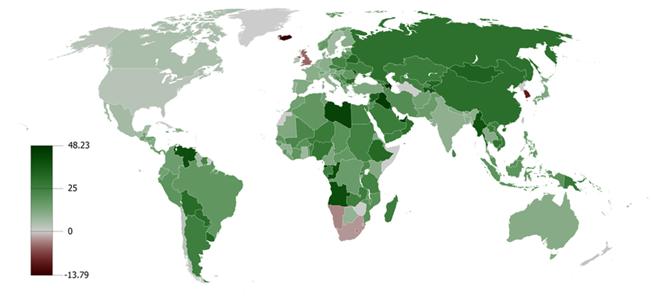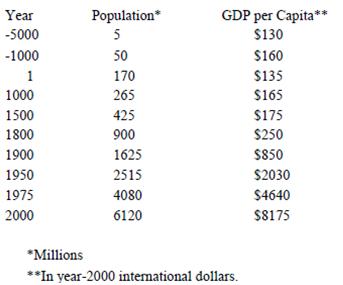Economy
Description:
Economic growth is a positive change in the level of production of goods and services by a country over a certain period of time. It is best measured by the growth in GDP.
The figure below shows the GDP growth around the world:
Traditional economic theory has suggested a trade-off between economic growth and environmental sustainability. Although income appears to have a beneficial effect on pollution measures, it has a detrimental effect on environmental sustainability as economic growth means a faster depletion of resources.
Enablers:
• Increase investment
• Increase in population
• Increase in consumption, which will increase GDP.
• Increase in government expenditure
• Increase in international trade: countries that are open to international trade grow faster than closed economies
• Increase in level of human capital
• Governance and Transparency
Inhibitors:
• Political and social instability
• Trade barriers
• Socialism
Paradigms:
It was an economic growth that revolutionized and changed the process of invention. Since 1850 the pace of invention and innovation has further accelerated: steelmaking, the internal combustion engine, pasteurization, the typewriter, the cash register, the telephone, the automobile. The economic growth marked the beginning of industrial revolution: the era in which it is expected that new technological leaps will routinely revolutionize industries and generate major improvements in living standards.
However, to support the economic growth, more resources had to be used. According to Paul and Anne Ehrlich's equation for human environmental impact,
I = P x A x T, where I = environmental impact, P = population, A = affluence, and T = technology.
This implies that any increases in population, wealth, and technology are inherently damaging to the environment, no matter what mitigating measures are possible. Using real data, we know that the amount of energy used and pollution emitted per dollar of economic activity has been increasing. Professor John Sterman, the self-described "Dr Doom" commented that if everyone on Earth tried to live the literal lifestyle of modern Americans, we would need 5-10 planets worth of resources and carrying capacity. Therefore, if economic growth meant the same material needs and consumptions per capita worldwide, then sustainability and growth are irreconcilable. Professor Sterman shared both data and general statistics showing that people generally have become conditioned to the notion that they always need more, especially more physical, material good and that this is inherently unsustainable.
Experts:
• Robert Solow, winner of the 1987 Nobel Prize in Economics. He is famous for the theories of economic growth.
• Paul Michael Romer, an economist and Senior Fellow at Stanford University's Center for International Development and the Stanford Institute for Economic Policy Research. He is an expert on economic growth.
• Kamer Daron Acemoğlu, Professor of Applied Economics at Massachusetts Institute of Technology and winner of the 2005 John Bates Clark Medal. He is also among the 20 most cited economists in the world. He is the associate editor of the Journal of Economic Growth and have interest in the field of economic growth
Timing:
Up until 1500: There had been almost no growth in output per worker for the average human.
Between 1500 to 1800: Average rates of material output per capita grew at 0.15% per year.
Between 1800 and 1900: Output per capita grew at 1.0% per year worldwide.
Between 1900 and 2000: Output per capita grew at 2.0% per year worldwide.
The economic growth in terms of GDP per capita and the population growth are shown below:
Web Resources:
http://en.wikipedia.org/wiki/Economic_growth

